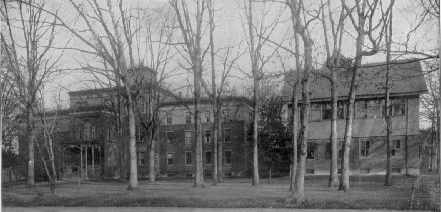|
|
1895 Female Institute & BU Cottage |

|
|
| During the 1869-70 academic year, the Female Institute Building was heated by hot air and had gas lighting. That same year, the South Hall wing of the Institute Building was erected.(not visible in the photograph but located in back of the Institute Building at the far left of the photograph) This wing contained dormitory rooms, and a gymnasium occupied the entire third floor where in 1895 classes in “Physical Culture” were conducted “…. for the benefit of all students….” and the “exercises practiced [were] such as tend[ed] to the development of grace and strength.”. By 1887, the cisterns had been removed from the cellars of the Institute Building and water was supplied by pipes from the Lewisburg Water Works. Also steam heating had replaced the hot air furnaces. In 1890, fire escapes and hoses had been provided for the building, and by the late 1890's water-closets and a sewage system had replaced the outbuildings and privies. In 1868, the Trustees had proposed that a course of study be developed for women "like the Collegiate course for men." In 1884, the faculty of the College were empowered to arrange a course of study that would allow graduates of the "Young Ladies Institute" to receive a Bachelor of Science degree, and in 1885 Miss Chella Scott received the first degree. In 1882, a second railroad passed through Lewisburg when the Shamokin, Sunbury and Lewisburg Railroad was constructed between Shamokin and West Milton. This railroad, which later became part of the Philadelphia and Reading Railroad, passed next to both the Female Institute and the President's House. The passenger depot was at the corner of South Fifth and Market Streets, and the freight terminal was at the intersection of St. Louis and South Fifth Streets. By 1895, the Lewisburg & Tyrone Railroad, with its passenger depot at the corner of St. John and North Second Streets, had become a part of the Pennsylvania Railroad. Bucknell Cottage In 1889, the Bucknell Cottage was erected with funds provided by a gift from William Bucknell. The architect was Wilson Brothers And Company of Philadelphia and the contractor was W.H. Waltz. This building, also called the Bucknell Cottage for Ladies, was located southwest of the Institute Building (to the right in the photograph) and was originally connected to it by an enclosed walkway. A brick building in Queen Anne-style architecture, the 33 feet x 100 feet structure included rooms for forty female students. Music In 1890, Elysee Aviragnet, who had been employed as professor of music and teacher of romance languages in the Institute in 1887, became the Director of the Institute of Music. Although music instruction was most closely related to the Female Institute, musical activities quickly spread to the Academy and the College. The School of Music offered lessons in piano, pipe organ, voice culture, harmony, violin, viola, violoncello, double bass, guitar, mandolin, clarinet, and coronet and horn. During the 1894-1895 Academic Year, most of the students were female except for instruction in clarinet and cornet and horn where all the students were male. Institute Programs in 1895 In 1895, the first floor of the Institute Building contained an office for the Principal, who was Mrs. Katherine B. Larison, a reception room, music rooms and a dining hall. A schoolroom, a parlor, a library room, and student rooms were located on the upper floors. In addition to work in art and music, the Institute offered three five-year programs, which were the Classical, the Latin Scientific, and the Literary. Women who completed the Classical Program could be admitted to the sophomore class of the College as candidates for the Bachelor of Arts degree, while those who completed the Latin Scientific Program could be admitted to the same class as candidates for the Bachelor of Philosophy degree. Charges and Accommodations In 1895, the charges for a boarding student were $230.00 per year. Day students were charged $55.00 per year, which included $36.00 for tuition and $19.00 for incidentals, etc. A student who occupied “….one of the large rooms, in the South Hall of the Main Building, by herself…” paid “extra room-rent.” Some pupils in the School of Music lived in the Female Institute. The charge for these pupils, which included one literary subject per term but did not include charges for instruction in music, was $195.00 per year. Faculty and Students During the 1894-95 Academic Year, a faculty of twelve instructors taught ninety-eight students enrolled in the Institute; one hundred and three students were receiving instruction in music in the School of Music; and, twenty-three students were receiving instruction in painting in the School of Art. Seventeen women graduated from the Female Institute in 1895. Of these graduates, nine women had lived in Lewisburg homes, eight of whom were residents of Lewisburg; the other eight women had lived in the Institute Building. Sixteen of the graduates were from Pennsylvania; one was from New Jersey. "for the benefit" and "exercises practiced..." CAT '94-'95, p. 116. "like the Collegiate course..." BT '46-'82 (7/29/1868) "Young Ladies Institute" BT '82-'20, p. 29 (6/24/1884) "...one of the large rooms..." CAT '94-'95, p. 128 The major sources for the information on this page are the Minutes of the Board of Trustees of Bucknell University, 1846-1882 (BT '46-'82) and the Minutes of the Board of Trustees of Bucknell University, 1882-1920 (BT '82-'20). Additional sources are Oliphant, Rise of Bucknell; Theiss, Centennial History; and the Forty-fifth Annual Catalogue of Bucknell University, 1894-95 (CAT '94-95) and the Forty-sixth Annual Catalogue of Bucknell University, 1895-96 (CAT '95-'96) |
|
|
This building in other years: 1865
| 1915 | 1945
| 1965 | 1985
| Current Back to the Bucknell History Page | Back to the 1895 Page |
|